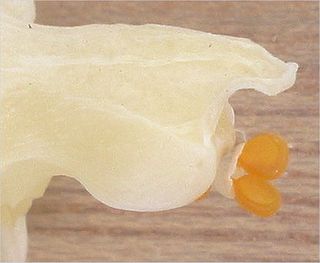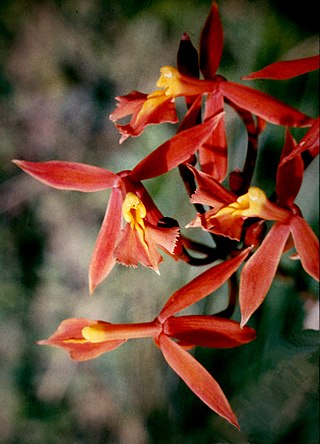
Orchids are plants that belong to the family Orchidaceae, a diverse and widespread group of flowering plants with blooms that are often colourful and fragrant.

Ophrys apifera, known in Europe as the bee orchid, is a perennial herbaceous plant of the family Orchidaceae. It serves as an example of sexually deceptive pollination and floral mimicry, as well as of a highly selective and highly evolved plant–pollinator relationship.

The stamen is the pollen-producing reproductive organ of a flower. Collectively the stamens form the androecium.

Cypripedioideae is a subfamily of orchids commonly known as lady's slipper orchids, lady slipper orchids or slipper orchids. Cypripedioideae includes the genera Cypripedium, Mexipedium, Paphiopedilum, Phragmipedium and Selenipedium. They are characterised by the slipper-shaped pouches of the flowers – the pouch traps insects so they are forced to climb up past the staminode, behind which they collect or deposit pollinia, thus fertilizing the flower. There are approximately 165 species in the subfamily.

A pollinium is a coherent mass of pollen grains in a plant that are the product of only one anther, but are transferred, during pollination, as a single unit. This is regularly seen in plants such as orchids and many species of milkweeds (Asclepiadoideae). Usage of the term differs: in some orchids two masses of pollen are well attached to one another, but in other orchids there are two halves each of which is sometimes referred to as a pollinium.

Plant reproductive morphology is the study of the physical form and structure of those parts of plants directly or indirectly concerned with sexual reproduction.

Epidendroideae is a subfamily of plants in the orchid family, Orchidaceae. Epidendroideae is larger than all the other orchid subfamilies together, comprising more than 15,000 species in 576 genera. Most epidendroid orchids are tropical epiphytes, typically with pseudobulbs. There are, however, some terrestrials such as Epipactis and even a few myco-heterotrophs, which are parasitic upon mycorrhizal fungi.

Gynoecium is most commonly used as a collective term for the parts of a flower that produce ovules and ultimately develop into the fruit and seeds. The gynoecium is the innermost whorl of a flower; it consists of pistils and is typically surrounded by the pollen-producing reproductive organs, the stamens, collectively called the androecium. The gynoecium is often referred to as the "female" portion of the flower, although rather than directly producing female gametes, the gynoecium produces megaspores, each of which develops into a female gametophyte which then produces egg cells.

The stigma is the receptive tip of a carpel, or of several fused carpels, in the gynoecium of a flower.

Hand pollination, also known as mechanical pollination is a technique that can be used to pollinate plants when natural or open pollination is either undesirable or insufficient.

Chiloglottis, commonly known as wasp orchids, ant orchids or bird orchids, is a genus of about 25 species of flowering plants in the orchid family, Orchidaceae and is found in eastern Australia and New Zealand. Wasp orchids are terrestrial herbs which grow in colonies of genetically identical plants. They usually have two leaves at the base of the plant and a single resupinate ("upside-down") flower. The labellum is more or less diamond-shaped and has calli resembling the body of a wingless female wasp.

The Proteaceae form a family of flowering plants predominantly distributed in the Southern Hemisphere. The family comprises 83 genera with about 1,660 known species. Australia and South Africa have the greatest concentrations of diversity. Together with the Platanaceae and Nelumbonaceae, they make up the order Proteales. Well-known genera include Protea, Banksia, Embothrium, Grevillea, Hakea and Macadamia. Species such as the New South Wales waratah, king protea, and various species of Banksia, Grevillea, and Leucadendron are popular cut flowers. The nuts of Macadamia integrifolia are widely grown commercially and consumed, as are those of Gevuina avellana on a smaller scale.
Plant reproduction is the production of new offspring in plants, which can be accomplished by sexual or asexual reproduction. Sexual reproduction produces offspring by the fusion of gametes, resulting in offspring genetically different from either parent. Asexual reproduction produces new individuals without the fusion of gametes, resulting in clonal plants that are genetically identical to the parent plant and each other, unless mutations occur.
This page provides a glossary of plant morphology. Botanists and other biologists who study plant morphology use a number of different terms to classify and identify plant organs and parts that can be observed using no more than a handheld magnifying lens. This page provides help in understanding the numerous other pages describing plants by their various taxa. The accompanying page—Plant morphology—provides an overview of the science of the external form of plants. There is also an alphabetical list: Glossary of botanical terms. In contrast, this page deals with botanical terms in a systematic manner, with some illustrations, and organized by plant anatomy and function in plant physiology.
This glossary of botanical terms is a list of definitions of terms and concepts relevant to botany and plants in general. Terms of plant morphology are included here as well as at the more specific Glossary of plant morphology and Glossary of leaf morphology. For other related terms, see Glossary of phytopathology, Glossary of lichen terms, and List of Latin and Greek words commonly used in systematic names.

Arthrochilus, commonly called elbow orchids, is a genus of about fifteen species of flowering plants from the orchid family (Orchidaceae) and is found in Australia and New Guinea. The flowers are pollinated by male thynnid wasps which attempt to mate with the flower and are held in place by hooks while the pollinium is transferred between insect and flower.

Caleana, commonly known as duck orchids, is a genus of flowering plants in the orchid family, Orchidaceae that is found in Australia and New Zealand. The Australian species are found in all states but have not been recorded in the Northern Territory. Duck orchids have a single leaf and one or a few, dull-coloured, inconspicuous flowers. Most species are found in Western Australia but one species occurs in eastern Australia and one occurs in eastern Australia and New Zealand. Orchids in this genus as well as the hammer orchids (Drakaea) are pollinated by male thynnid wasps.

The monocots are one of the two major groups of flowering plants, the other being the dicots. In order to reproduce they utilize various strategies such as employing forms of asexual reproduction, restricting which individuals they are sexually compatible with, or influencing how they are pollinated. Nearly all reproductive strategies that evolved in the dicots have independently evolved in monocots as well. Despite these similarities and their close relatedness, monocots and dicots have distinct traits in their reproductive biologies.

The pollination of orchids is an extremely complex chapter in the biology of this family of plants that are distinguished, above all other angiosperms, by the complexity of their flowers and by the intricate ecological interactions with their pollinator agents. It is a subject that has captured the attention of numerous scientists over time, including Charles Darwin, father of the theory of evolution by natural selection, who made the first observations about the fundamental role of insects in orchid pollination, which were published in 1862 in his book The Fertilization of Orchids. In fact, Darwin was not exaggerating when he claimed that the varied stratagems orchids use to attract their pollinators transcend the imagination of any human being.

In botany, floral morphology is the study of the diversity of forms and structures presented by the flower, which, by definition, is a branch of limited growth that bears the modified leaves responsible for reproduction and protection of the gametes, called floral pieces.


















